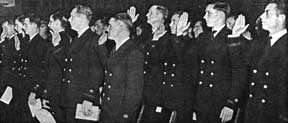U.S. Maritime Service Officer Training School
Alameda, California (1943-1954)Background of the United States Maritime Service
In 1936 Congress passed the Merchant Marine Act of 1936 which was known as the "Magna Carta" of the Merchant marine. This Act established the United States Maritime Commission, which was charged withe responsibility of seeing that American ships were "manned with a trained and efficient personnel." After considerable study the Maritime Commission proposed a program limited to men who had sea experience, and on June 23, 1938, Congress amended the Merchant Marine Act of 1936 to provide for the Maritime Commission's program. On that day the United States Maritime Service was born. The amendment directed the Commission to establish the U.S. Maritime Service as an organization with the same ranks and rates prescribed for the United States Coast Guard.At right: Memorial at site of Alameda U.S. Maritime Service Officer School (2001) Inscription reads: In memory of the Graduates of this Station who gave their lives in the service of their country --- 1941 - 1945
Three weeks after the authorization, the Commission the initial training program started with the acquisition of Hoffman Island in lower New York Bay. Once a quarantine station for immigrants, Hoffman Island served as a Coast Guard training station during World War I.
On September 7, 1938, the first group of trainees arrived. Soon afterward a second station was opened on Government Island, San Francisco Bay, located between Alameda and Oakland [Present day name is Coast Guard Island.]. By the end of the year 389 licensed officers and unlicensed men were in training at both stations. It was anticipated that when full facilities were available, 300 licensed and 3,900 unlicensed personnel would be trained annually. U.S. Coast Guard facilities and personnel administered the 90 day training program for men having at least 2 years' experience at sea. Fort Trumbull, Conn. was opened on January 1, 1939.
Temporary barracks and training center before the school was built was on the Mississippi River Boat, the Delta Queen. About 1400 men were stationed on it. Training classes took place in the salon.
Delta QueenThe U.S. Maritime Service Officer School operated in Alameda from 1943 until its closing in 1954. The Training School was opened on January 29, 1943 and dedicated on July 10, 1943. It was set up to train officers for the U.S. Merchant Marine. By August of 1943 nine hundred officers had been trained, and before its first anniversary the base had sent 2,000 officers to sea either as third mates or third assistant engineers.
The minimum requirement of 18 months previous sea experience was later lowered to 14 months. After World War II it was required to have 36 months sea experience before sitting for a license examination. Around 2000 officers a year were trained.
Class of Summer 1942 Torpedo Club
(l. to r.) S.T. Clark, A. Olson, A.D. Lewis, Frank Dixon, R. Carlisle, J.E. Easton. Some torpedoed once, some twice, one three times.C. Dudley Cantua
(From FULL and DOWN, Summer 1942 Yearbook; courtesy of C. Dudley Cantua, Member of East Bay Mariners, AMMV )
U. S. Maritime Service Officer Training School
Alameda, CaliforniaAt the gateway to the Pacific, where our merchant fleet heads out for Alaska, Australia, the Marshalls and other island bases "down under,'' is located one of two schools in this country where Merchant Seamen can come off their ships and earn officers' papers. There are undoubtedly other schools that resemble this particular station in both physical appearance and the men themselves who are ambitious enough to tackle the tough course.
Welcome to AlamedaSignificant, however, is that fact that here --- the U. S. Maritime Service Officers School in Alameda, Calif. --- is the only station on our western coast where a seaman can come ashore, sharpen up his technical knowledge in up-to-the-minute courses, and return to his ship with gold braid on his sleeves and an officer's license in his pocket.
But the training isn't as simple as all that. In fact, it's downright tough. The brevity of the training period, four months, and the amount of material that has to be covered, which is truly tremendous, is an indication of how hard the officer candidates have to work. Graduation from the station is a real achievement. Candidates not only lead a stiff life academically but in every other aspect as well. Discipline is strict and orders are carried out to the letter. Every thing runs like clockwork.
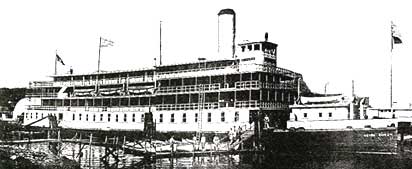


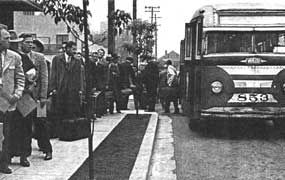
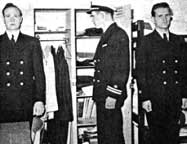
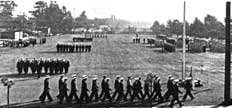


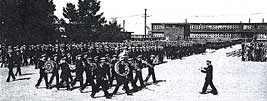
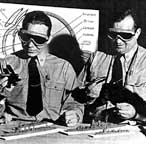
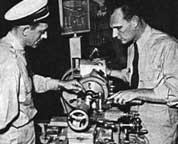
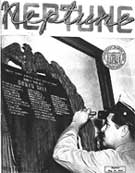
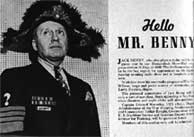 Hello
MR. BENNY!
Hello
MR. BENNY!

